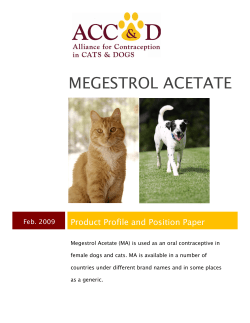
ANNUAL REPORT 2013 HUMANE ANIMAL WELFARE SOCIETY
HUMANE ANIMAL WELFARE SOCIETY ANNUAL REPORT 2013 701 Northview Road, Waukesha, WI 53188 PRESIDENT’S MESSAGE Another year has passed in the HAWS world, and thousands of people and animals have passed through our doors – all with different stories and different outcomes. In a perfect world, all of our customers would leave with a smile, but that is not quite realistic. Our mission at HAWS remains the same: we are all about the animals and their welfare. 2013 has emerged as a year when the biggest challenge is educating the public about our mission and our position in the community. It has become important that we explain the difference between “no kill” and HAWS’ promise as an “open admissions” shelter. There are many different types of shelters. At HAWS we believe it is important to remain open admissions while working towards the goal of being a no-kill community. But what is the difference? Many shelters and rescues use the phrase “no kill” to describe what happens…or doesn’t happen to the animals in their care. These facilities never euthanize a resident animal, for any reason, at any time. This policy means a facility must turn away animals when they become full, and they will not accept animals that do not fall into their definition of “adoptable.” “Open admissions” shelters will accept ANY animal, ANY time, for ANY reason. While this sounds like a perfect world, it creates a situation where, along with healthy and adoptable pets, the facility will accept animals that are old, sick or aggressive. Without humane euthanasia, the facility can quickly become populated with animals that are not adoptable. HAWS is an open admissions facility. As a Board and an organization, we decided long ago that this was the correct way to run our organization. Instead of sending a frantic pet owner back out through our doors with a sick kitty, we accept the animal and gently and humanely send it “over the bridge” if it cannot be medically treated. Instead of sending the aggressive dog home with its weary owner to possibly be released to the streets, we accept the animal, attempt rehabilitation and, if unsuccessful, we give that animal a gentle and peaceful end. It is a tough position to be in, and HAWS never takes losing an animal lightly. Two examples from this spring brought our open admissions position to the forefront. The first was the case of the elderly person whose property and home were overrun with more than one hundred cats. Some were already deceased, but many were alive. HAWS stepped in and brought all the cats to the shelter leaving none behind. We treated and saved the ones we could, socialized them and adopted them out. The ones that were suffering were gently and humanely euthanized. It was heartbreaking for the staff and volunteers, but it was the right thing to do for those cats. Cats from this situation would have been rejected by most “no kill” facilities because they all required extensive care, rehabilitation and socialization before being considered “adoptable.” The next situation happened barely three weeks later. An area puppy mill called a local rescue group on Good Friday, challenging them to remove “a bunch” of dogs from his property or he would kill them all within 2 days. The rescue group was given until midnight Easter Sunday to remove the dogs. Upon request from the rescue, HAWS’ staff members joined them early on Easter Sunday, removing 51 small dogs from the facility. By Sunday evening, all the dogs had been given fresh food and water, safe haven and tender care. All but two of the dogs were saved – with those 2 suffering from advanced medical issues. Some of the dogs went to local rescue groups after receiving medical care, spay/neuter surgery and grooming from HAWS. HAWS was able to adopt out the rest to loving families that were carefully picked for their compassion and patience. These dogs would have been turned away by a “no kill” shelter because very few would have met the “adoptable” criteria. HAWS’ open admissions position is not always the easiest. It is much harder to accept, treat, rehabilitate and nurture these animals than it would be to turn them away. We are passionate that our way is the right way for our community. Now comes your job as HAWS’ supporters and animal rights advocates! Your job is to EDUCATE, EDUCATE, and EDUCATE some more. You are out in the community…at church and school and social events. When you are asked the question “Is HAWS a no kill facility?” please remember my message. Hand out our literature and offer to arrange a tour of our great facility. Any Board member or staff person will be happy to show the public who we are and what we do. As an organization, we can only do so much: THE REST IS UP TO YOU!! Cindy Pechanach President, Board of Directors As our president spoke about no-kill shelters and open admission shelters, I would like to reinforce the valuable programs we offer at HAWS. We are dedicated to programs to move us in the direction of a no-kill community. These programs will offer long term solutions to end pet overpopulation and change attitudes about responsible pet ownership. We manage to find homes for all adoptable dogs. Space is no longer an issue with canines in Southeastern Wisconsin. Behavior issues are what bring the majority of dogs to us. We work to fix behavior issues where we can – before the dogs leave here – so they have a better chance of staying in their new homes. Where we don’t adopt out dangerous or bite case dogs, we work hard to save all of them that we can. This year, 198 dogs participated in our Behavior Department’s Mod Squad program. Along with medical assistance for those that require it, we are able to turn nonadoptable dogs into adoption candidates in many situations. With cats the story is not as positive. The key to solving the problem of cat overpopulation lies in spay-neuter surgery, especially of outdoor cats. Outdoor cats can have up to 3 litters each year, increasing their population exponentially. We have secured funding from the Friends of HAWS group for the past year to offer free spays and neuters of outdoor cats through Project Guardian. We have been successful in lowering the incoming number of animals, but our work is not done yet. We look forward to a time where cats, like dogs, have more people looking for them than we have animals available for adoption. Incoming Animals EXECUTIVE DIRECTOR’S REPORT 2000 1800 Our past year was a great one. Spring was a reminder of why we are here, with the intake of 144 cats from the hoarding house followed nearly immediately by the 51 dogs from the puppy mill situation. The staff took both of these situations in stride and we rolled right into the busy summer without missing a beat. As an open admission shelter, HAWS will deal with situations like this from time to time, but back-to-back was a challenge on resources. Our community stepped up to assist. 1600 1400 1200 2010 2011 1000 800 2012 600 400 2013 200 0 Dogs Cats Puppies Kittens Misc. Education is another area in which we have made a huge commitment. By educating people on responsible pet ownership, and by reinforcing values such as compassion, kindness, nurturing and parenting skills to youth, we are building a stronger community. Here are some program highlights: 1099 cats, 468 dogs and 788 small animals were adopted this year. That is 100 more cats than last year and 10 more dogs. Small animal adoptions include the goldfish we received in November. Project Guardian spayed or neutered 505 outdoor breeding cats while doing 3251 total surgeries this past year. This will prevent countless litters from being born and becoming excess pets and prevent their litters from also adding to the population explosion. Our Animal Rescue Team helped 530 wild animals. 663 pets were reunited with their families due to the efforts of our staff. 89% of the stray dogs were reclaimed along with 13% of our stray cats, much higher than the national average. Annie’s Fund spent $10,211 to rehabilitate animals this year. In addition, many were treated in-house by our strong veterinary team. 198 dogs went through behavior modification programs with the Mod Squad this year. Over 700 dogs have received help from this life-saving program since it began. 5744 attended Education Programs at HAWS in the past year with 334 participants in our dog training classes. We began Kitty College to go along with our dog training programs and puppy classes. 80 dogs received Pre-adoption Counseling to give their owners a better chance to transition their new pet into their home. Volunteers offered 46,130 hours of service from assisting with kennel and maintenance chores to helping in our veterinary clinic and office. We could not do what we do without the volunteers. They help keep our pets socialized, and pick up our spirits as well! We also cannot continue to tackle the difficult problems of pet overpopulation, homeless animals and compassion training without donations of many types. A substantial difference can be made to the well-being of our organization’s mission and the Adoption Rates 800 700 600 500 2010 400 2011 300 2012 200 2013 100 0 Dogs Cats Puppies Kittens Misc. animals in our care by leaving a gift to HAWS in your will. Bequests, estate gifts, stock or even a required minimum distribution can make a sizeable impact. In 2012 we received several wonderful bequest gifts which, along with donations of all types, helped us help the animals and educate the public. Consider including HAWS in your will or estate planning and leave a legacy for tomorrow’s animals, too. Lynn Olenik Executive Director ____________________ HAWS Mission Statement: The Humane Animal Welfare Society of Waukesha County leads the community in animal welfare and assures sanctuary for animals in need. We envision a community where all animals are treated with compassion, dignity and respect. We invite the public to join us in our cause to spread humane sentiments throughout our community for the betterment of animals and people alike. Board of Directors Cindy Pechanch, President Michael Nell, First Vice-President Kenneth Petershack, Second Vice-President Bill Stone, Treasurer Carol Wehrman, Corporate Secretary Sabrina M. Bryant Fred Hilton Gretchen Jaeger, DVM Nancy Mayo Kerry Schnier Susan Sorrentino Stewart Wangard Staff Members Administration Lynn Olenik, Executive Director Mark Hess, Field Services & Facilities Manager Kelly Rohda, Shelter Manager Sara Stoss, Volunteer Coordinator Jennifer Smieja, Development Coordinator Jessica Pinkos, Events Coordinator/Adoptions Lead SNIP Clinic – Spay/Neuter Initiative Program Kolleen Meyer, DVM Kenneth J. Wolterman, DVM Cassie Gugin, Clinic Manager Lindsay Monroe, Clinic Tech Adoption Services Johanna Schmanski, Mobile Adoptions Coordinator Kristie Benjamin Leann Boucha Whitney Callies Andres Garcia Ashley Hodel Louanne Mooney Angela Ng Kim Ng Rachel Stanich Kim Wasser Staff Members (Continued) Animal Care Kim Kalczynski, Kennel Lead Jaime Merkel, Kennel Lead Stephanie Brandt Katie Brock Sam Depue Alysha Hansen Elizabeth Hoskins Tia Kocontes Hailey Nelson Kelsea Patterson Ben Posanski Savannah Walczak Trina Washebeck Bree Young Education Department Khris Erickson, Humane Educator Megan Katzuba, Education Assistant Behavior Department Dr. Claudeen McAuliffe, Ph.D.,CAP-2, CDBC; Manager Leann Boucha, Trainer Ashley Hodel, Trainer Timothy Reed, Trainer Kirsten Watry, Trainer Alison Wiersma, Trainer Sara Wiesner, Trainer Road Response Team Alysha Hansen Ashley Hodel Hailey Nelson
© Copyright 2025











